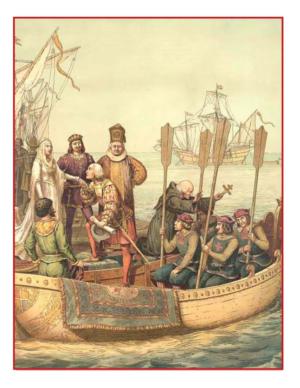(Front Cover: The Departure of Christopher Columbus from Spain, 1492. Queen Isabella, his benefactress, receives his homage.)
The Voyage of Columbus and Columbus Day
On August 3rd, 1492, an Italian navigator Christopher Columbus set sail from Palos, Spain with a squadron of three ships: his flagship the Santa María, and two smaller ships, the Niña and the Pinta. These three ships together carried 120 men. Under the patronage of Pastor’s Note Isabella, the Queen of Spain, their mission was to sail west in the expectation that a sea trading route from Europe to the Far East could be found.
The very launching of this expedition represented an astonishing turn of fortune for Columbus. For years he and his brother Bartholomew had been trying to interest nobleman and monarchs in a scheme to discover the Far East by sailing westward. In January of 1492, Christopher Columbus and his son Diego (who was then 16) showed up outside a Dominican friars’ convent on the road from Granada, begging hospitality for the night. They had come from the military camp of King Ferdinand who been engaged in the final battle against the Muslims in Spain. The King and his council had had no interest in the sea-farer’s costly and dreamy scheme. So now, his last best chance destroyed (Bartholomew Columbus had already been rejected by Henry VII of England and Charles VIII of France), the father and son were out on the road, in poverty, and without a real plan.
While Columbus was trying to talk the porter of the convent into letting at least his son stay the night, the Prior, Father Juan Perez, was standing by and listening. Something about this man intrigued him. He had both of them admitted to the convent as guests. Later that night, Fr. Perez invited Christopher to his cell where he heard of the grand design and was won over to it.
Fr. Perez was the Father-confessor to Queen Isabella. He took it upon himself to go to the Queen and try to get her to take a personal interest in Columbus’s proposal. The Queen was persuaded and she in turn persuaded her husband King Ferdinand to give the man another hearing. Columbus was called to court at once. On April 17th, 1492 the first agreement with the Crown was signed and on April 30th the second.
At the point of departure, the new Admiral Columbus received the Sacraments of Penance and Holy Eucharist from Fr. Perez, who had been the catalyst for the realization of this voyage. The crewman followed Columbus’s example and also took the Sacraments.
On the night of October 11th, Columbus perceived a light which indicated land. The next morning, October 12th, Columbus landed on an island in the Bahamas and christened it “San Salvador” (“Saint Savior”, for Jesus Christ). The natives of the island were friendly. Thus began the European discovery of the American continents, a great moment in history which we celebrate with our national holiday of Columbus Day.

